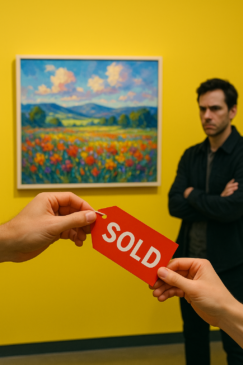Artists are used to pouring their souls into their work. Each piece is a glimpse into your heart, hours of effort, trial and error, and pure imagination made visible. For me, painting has always been more than a hobby—it’s therapy, a form of self-expression, and, lately, a fragile hope for a new career. That’s why it cut so deeply when my friend—not just anyone, but someone I trusted—took credit for my artwork and sold it as her own.
How I Discovered the Truth
It started with a message from another artist on Instagram: “Saw your painting at the Willow Street Gallery show—didn’t know you were showing!” I blinked in confusion. I hadn’t entered anything in that show. Curiosity turned to shock as I scrolled through the event’s tagged photos and spotted my piece—my brushstrokes, signature style, unmistakable palette—hanging in the background. But beneath the frame was a label with my friend Anna’s name.
Anna and I had painted side by side for years. We’d shared ideas, traded critiques, and even collaborated once or twice. I trusted her with my art, letting her borrow pieces for her apartment and showing her unfinished works.
The next day, I visited the gallery. There, in full display, was my painting with a red “SOLD” sticker beneath Anna’s name. The gallery manager congratulated me on my “amazing piece” before I corrected him: “I didn’t submit this. That’s my work, but I’m not Anna.”

The Confrontation
I called Anna that night, my hands shaking. “Why is my painting hanging in that gallery under your name?” I asked.
She hesitated, then mumbled about a deadline, how she “just needed one more piece to fill out her show.” She never expected it to sell, she said, and planned to “split the money with me.” But she’d never asked. She’d never even told me.
I felt a mix of anger, heartbreak, and disbelief. “You didn’t just borrow my art, Anna. You claimed it. You erased me.”
Her apology was clumsy, full of excuses about nerves and desperation. But the damage was done. Trust, once broken, can’t be painted over.
What Happened Next
I asked the gallery to correct the record and contacted the buyer. To their credit, both were sympathetic and horrified. The gallery updated the attribution; the buyer, though disappointed, understood my position and supported the switch. Anna’s reputation took a hit. Our friendship ended—painfully, but necessarily.
I learned to be vigilant with my work, to watermark digital images and keep better track of what I lend out. Most importantly, I learned to value my own voice—enough to fight for it when someone tries to silence it.
What I Learned
Creativity deserves respect, and so do you. No relationship—friendship, partnership, or otherwise—should ever cost you your integrity. When someone crosses a boundary that deeply, it’s not your job to quietly forgive or make it easy for them. Speak up. You’re worth protecting.
Final Thought
If your work or your voice is ever stolen, remember: the world deserves to see your truth, not someone else’s version of it. Protect your art, protect your story, and never let anyone sell your dreams as their own.



